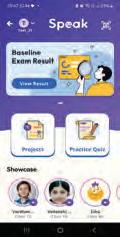






Achieve Fluency in Verbal Communication

Academic Authors: Chandani Goyal, Anuj Gupta, Kashika Parnami, Laraine O’Connell
Creative Directors: Bhavna Tripathi, Mangal Singh Rana, Satish
Book Production: Sanjay Kumar Goel, Tauheed Danish
Project Lead: Sneha Sharma
VP, Learning: Abhishek Bhatnagar
All products and brand names used in this book are trademarks, registered trademarks or trade names of their respective owners.
© Uolo EdTech Private Limited
First impression 2023
Second impression 2024
Third impression 2025
This book is sold subject to the condition that it shall not by way of trade or otherwise, be lent, resold, hired out, or otherwise circulated without the publisher’s prior written consent in any form of binding or cover other than that in which it is published and without a similar condition including this condition being imposed on the subsequent purchaser and without limiting the rights under copyright reserved above, no part of this publication may be reproduced, stored in or introduced into a retrieval system, or transmitted in any form or by any means, electronic, mechanical, photocopying, recording or otherwise, without the prior written permission of both the copyright owner and the above-mentioned publisher of this book.
Book Title: Conversations Teacher Manual 3
ISBN: 978-81-984293-2-2
Published by Uolo EdTech Private Limited
Corporate Office Address: 85, Sector 44, Gurugram, Haryana 122003
CIN: U74999DL2017PTC322986
Illustrations and images: www.shutterstock.com, www.stock.adobe.com and www.freepik.com
All suggested use of the internet should be under adult supervision.
In the age of globalisation and unprecedented technological advancement, English stands as a universally comprehensible medium of communication. It has evolved into one of the essential tools that learners require to thrive in today’s world and secure their future. Studies from across the globe have also shown that English communication skills have a significant impact on career prospects and lifelong learning.
Functional and fluent communication skills in English, encompassing the crucial facets of LSRW (Listening, Speaking, Reading, and Writing), are pivotal for children’s knowledge acquisition; intellectual, social, and emotional development; and lifelong learning.
Robust listening and speaking skills not only form the bedrock of the language learning process but also pave the way for enhanced reading and writing capabilities. Yet, the majority of educational efforts prioritise teaching reading and writing from the very outset, sometimes neglecting listening and speaking skills. These foundational skills are often overlooked in educational institutions due to high pupil-teacher ratios, lack of opportunities to express themselves in English and, most significantly, a lack of structured and dedicated class time for honing these skills.
It is within this context that Uolo Speak has been introduced as a groundbreaking English program tailored for learners in pre-primary to grade 8, with a special emphasis on English listening and speaking. Uolo Speak aligns with the National Education Policy (NEP) of 2020 and the learning outcomes set forth by the National Council of Educational Research and Training (NCERT).
The Conversations book serves as the classroom-based avenue for developing functional speaking skills. The book contains teacher-led English speaking and listening activities that adhere to the highly recommended and research-based teaching-learning method known as the Gradual Release of Responsibility (GRR). This approach systematically guides learners to master the targeted competencies. Through these activities, learners engage in high-quality, age-appropriate, and experiential tasks that foster confidence and fluency in English. The accompanying Teacher Manual provides in-depth implementation plans for these activities.
The mobile interface of this educational product ensures consistent practice of functional English skills. These exercises transcend conventional question types, employing cutting-edge technology to facilitate learning and provide instant feedback. For instance, learners can practise English speaking on the App and receive AI generated feedback. This allows learners to grow skills over a period of time and gain confidence to express themselves in English in their daily lives.
Uolo Speak offers a potent, captivating, and unique learning experience for learners. It embodies a pragmatic, results-oriented approach to cultivating indispensable functional English skills required for the 21st century. We extend our warmest wishes to all educators, parents, and learners as they embark on this exciting journey with Uolo Speak, filled with fun and joyful experiences.

Dr Laraine O'Connell
D. Litt., English, North West University, South Africa
I am a veteran English teacher and lecturer, with a great love for English and for teaching. I have taught English and trained teachers over many years. I live in South Africa and it is a wonderful experience working with a company promoting the learning of English in India.
Welcome to the Speak journey!
The program is a thoughtfully crafted activities-based learning experience that build students’ speaking skills in English. The program, with dedicated time and space within the classroom, becomes a platform to practise speaking and listening skills in everyday scenarios. These scenarios are created by way of teacher-led activities, which cater to specific competencies in English.
Course Book
Speak on the Spot Activities
Prepared-speaking Activities
Teacher Manual
Student and Teacher Apps
Talking Books
Listening and Speaking Projects
Interactive Practice Quizzes

The classroom program is augmented by the digital world, which is presented to the students through the UOLO App. The app includes projects that are closely associated with the activities in the coursebook. The projects, that are AI evaluated, allow children to have fear-free practice time at home. The app also includes quizzes in listening, speaking, reading and writing that can be done at home.

The National Education Policy (NEP) 2020, introduced by the Government of India, represents a transformative shift in the country’s education system. It aims to create a more holistic, dynamic and multidisciplinary approach to education. NEP 2020 focusses on fostering conceptual understanding, skills, values and competencies that align with the demands of the 21st century, while also preserving India’s rich cultural heritage. UOLO is fully committed to actualising the vision of NEP 2020 by meticulously adhering to its outlined recommendations.



1. Comprehension and understanding
2. 21st century skills, values and dispositions
Competency Based Education
3. Application in real life




4. Holistic and integrated learning
5. Enjoyable and engaging
6. Collaborative and exploratory activities
NEP Pages 12, 17, 22
Teaching and Learning Pedagogy
7. Technology based solutions

NEP Pages 3, 11, 12, 27
8. Assessment of core concepts and application skills Assessments
NEP Pages 12, 18, 22
Exposure to rich literature, as stories and poems, that demonstrate essential speaking behaviours and competencies.
1 2 3 4 5
Vocabulary development—through the book and digital interface—to build mastery of new words, usage and expression.
1 2 7
Enhanced listening comprehension and elevated English learning experience through animations that bring each text to life.
1 5 7

Digital projects and supportive platforms that present English speaking opportunities in a fear-free environment.
2 3 4 5 7 8
Classroom activities and presentations that help build confident expression and language usage in everyday scenarios.
2 3 4 5 6 8
1 Comprehension and understanding
2 21st century skills, values and dispositions
3 Application in real life
4 Holistic and integrated learning
5 Enjoyable and engaging
6 Collaborative and exploratory activities
7 Technology based solutions
8 Assessment of core concepts and application skills

“In the 21st century, language teaching must go beyond traditional approaches and must aim to enable students to use language skills in real-life contexts for a wide variety of purposes.” (NEP, 2020)
According to Vygotsky and Krashen’s theory of second language teaching, language acquisition happens best when learners are engaged in purposeful and meaningful tasks in an anxiety-free, non-judgmental, communication-oriented, input-rich, supportive and stressfree environment, along with a lot of scaffolding practices. This approach to second-language teaching is also highlighted by the NIPUN Bharat Mission document and NEP, 2020.
In this context, the Conversations series, along with the learning activities designed in it, can play a crucial role in creating an input-rich environment, employing diverse avenues for speaking practice in a fear-free and non-judgemental setting, coupled with real-time feedback.
The book has been developed based on the ‘Gradual Release of Responsibility’ (GRR) model—a teaching-and-learning model that has been widely recommended by the NEP, 2020 and the NCF, 2023. The GRR has been promoted by educational researchers and practitioners all over the world for its effectiveness in promoting student engagement and deep understanding of content and skills.
The GRR model includes three steps, each one consecutively shifting the ‘responsibility’ from teachers to learners so that learners become independent users of the language.
I do: The teacher first provides explicit instructions and modelling that initiate the learning process.
We Do: As learners begin to grasp the content and skills, the teacher also begins to shift the responsibility to them, facilitating a guided practice where the teacher and the learners participate collaboratively.
You Do: Finally, the learners take full ownership of their learning through independent practice and the application of the skills learnt in the program.
Based on this approach, there are three core instructional models on which the activities work (please refer to lesson plans in the Teachers' Manual for greater clarity). These are:
Fully guided; Modelled speaking by the teacher
Collaborative: Shared speaking between the learners and the teacher
Independent practice and application by the learners
To sum it up, this has been created with a view to doing away with the fear of speaking in English among learners and allowing them to express themselves confidently in English in reallife situations.
The National Curriculum Framework for Foundational Stage (NCF) , released in 2023, is developed based on the vision of the National Education Policy (NEP) 2020, and to enable its implementation. The NCF provides guidelines for designing school syllabi and textbooks in India. It aims to improve the quality of education by making it more relevant, engaging, inclusive, and learner-centric. To achieve this, the NCF has articulated precise Learning Standards through well-defined Curricular Goals and Competency statements. These statements serve to harmonize the syllabus, content, pedagogical practices, and assessment culture, ensuring a cohesive and comprehensive educational experience. Curricular Goals: Curricular Goals are statements that give directions to curriculum development and implementation. They are derived from Aims and are specific to a Stage in education.
Competencies: Competencies are learning achievements that are observable and can be assessed systematically. These Competencies are derived from the Curricular Goals and are expected to be attained by the end of a Stage.












C-1.1 Converses fluently and meaningfully in different contexts
CG-1 Students develop oral language skills using complex sentence structures to understand and communicate abstract ideas.












C-1.2 Describes an outline of the material that has been read out and answers questions related to it


















C-1.3 Summarizes core ideas from the material that was read out
C-1.4 Demonstrates the ability to speak their reasoning coherently
C-1.5 Makes oral presentations (class debates, short welcome notes, anchoring of small events, short speech, and so on)
C-4.1 Uses knowledge of homophones, word roots, affixes, suffixes, synonyms, and antonyms
CG-4 Students acquire a more comprehensive range of words in various contexts (of home and school experience) and through different sources.












C-4.2 Discusses meanings of words and develops vocabulary by listening and reading a variety of texts or other content areas
The AI Cam by Uolo is a cutting-edge tool designed to help teachers capture and share classroom moments. This innovative technology enables teachers to effortlessly take photos and videos using their smartphones. AI Cam uses facial recognition technology to automatically identify students. All recordings are securely stored in the cloud and can be conveniently shared with parents via the Uolo Learn App. Uolo’s AI Cam makes capturing and sharing school memories simple, secure and meaningful and allows parents to cherish every milestone of their child’s educational journey.
How to Use AI Cam
1. Open the Speak program and click on the AI CAM button.
2. For facial recognition to work, enable the Autotagging feature by clicking on the banner and uploading the profile pictures of the students. Ensure that you upload profile pictures for most of the students in class to activate autotagging.
3. Choose either the Photo or Video option to capture classroom activities.
4. Begin recording a student’s submission. Once the recording is complete, click Next.
5. To record multiple submissions, click the Record More button. Alternatively, click Proceed to move forward.
6. Tag the classroom and topic associated with the submission, then click Save.
7. If the student’s profile picture has been uploaded, the Uolo app will automatically tag the student. Alternatively, tag the student manually.
Dos and Don’ts for Using AI Cam in the Classroom
You should:
1. seek written consent from parents at the beginning of the academic year.
2. capture academic or extracurricular activities that highlight the child’s progress, achievements, or active participation in class.
3. Ensure that there is good lighting, a distraction-free background, clear audio, and proper framing to make the videos clear.
4. communicate the purpose of sharing the videos with parents, for example celebrating milestones or updating a student’s progress.
5. record only what is relevant, positive and in line with the school’s guidelines.
6. be mindful of cultural norms and practices when recording activities or interactions.
7. ensure that all voices, actions, and language used in the recordings are respectful, formal, and encouraging.
You shouldn’t:
1. record a child without obtaining prior parental permission.
2. use unauthorised devices for recording or sharing videos.
3. upload videos to social media or public platforms without explicit consent.
4. capture moments where a child is upset, uncomfortable, or in a vulnerable state.
5. record or share any content that is offensive or inappropriate in any way.
Uolo Edtech Pvt. Ltd. strictly opposes the sharing of videos that are culturally or religiously sensitive. All recordings must align with the values of inclusivity, respect, and privacy, ensuring that no content infringes upon individual beliefs or sentiments.

1 When and Where?
Sharing date, time and place
2 It’s Rhyme Time! Rhyming lines
3 All About My Day Sharing one’s daily routine
4 Dos and Don’ts! Talking about rules
Identify key details about date, time and place
Tell the date, day, time and place correctly, using simple sentences
Enjoy listening to poems
Create and sing short rhyming lines
Share one’s daily routine, including all key activities
Talk about one’s daily routine with action and expression
Identify dos and don’ts of doing simple tasks
Say the dos and don’ts in a simple task 5 My Choices Sharing likes and dislikes
Identify others’ likes and dislikes
Share one’s likes and dislikes 6 Think and Tell Describing something
Identify key details from the given descriptions
Describe a person, place, animal or thing in a few lines 7 Daily Conversations Conversations in daily life
Ask questions during a conversation
Respond politely during a conversation 8 I Feel Discussing feelings with others
Can You Direct Me? Giving and following directions
Talking about the advantages and disadvantages of something
Talking About Local Events Reporting an incident or event
Answer questions related to one’s feelings
Discuss feelings with others
Follow simple directions
Give simple directions
Answer simple questions about a personal experience
Talk about a personal experience in a few lines
Identify advantages and disadvantages of certain things
Talk about a few advantages and disadvantages of something
Share details of a local incident or event
Answer questions about a local incident or event
In order to ensure participation of the maximum number of learners during the classroom presentations and to keep the surprise element going, you can try the following quick games for inviting learners to participate:
• Randomly pick the learners’ names written on chits / ice cream sticks / playing cards.
• Ask the learners to write code names for themselves on a chit. Randomly pick the chit from the jar and ask who it belongs to.
• Call out the roll number randomly.
• Say some unique identification markers, e.g. the one who is carrying a blue water bottle, the one who has a red bag, the one who was born in the month of March, the one whose birth date is 15, the one who has curly hair, the one who has two ponytails, the one who was born on the same date as that on which the lesson is being taught, the one who has the same roll number as the date when the lesson is being taught.
• Throw a ball of paper or a plastic ball and give an opportunity to the one who catches it.
• Throw a ball of paper or a plastic ball and give an opportunity to the person who is sitting next to the one who catches it.
• Sing a song/recite a poem while students swiftly pass an object from one to the other. The one who is holding it when the song/poem ends, has to present.
• After their presentation, each student invites the next presenter.
• Open a book randomly at a page. Call out that (roll) number for presentation.
• Pick any letter flashcard from a pile of flashcards. Choose the one whose name starts/ends with that letter.
• Pick any learner’s identity card / passport-size photograph / notebook placed upside down on a table. Call that student for a presentation.
• Roll a dice once to call out a single digit (roll) number, or roll a dice twice to call out a double digit (roll) number for presentation.
• At the count of three, the learners as well as the teacher show a number from 1-10 using their fingers. The learner whose number matches the teacher’s will be invited to present.
• Play stone, paper, scissor with the whole class. Invite those students first whose action matches yours.
• At the count of three, the teacher as well as the learners will show a colour flashcard. The learners whose colour matches with the teacher’s is invited to present first.

Speak on the Spot Plan and Speak Speak on the Spot Plan and Speak Speak on the Spot Plan and Speak Speak on the Spot Plan and Speak Speak on the Spot Plan and Speak Speak on the Spot Plan and Speak Speak on the Spot Plan and Speak Speak on the Spot Plan and Speak

Speak on the Spot Plan and Speak Speak on the Spot Plan and Speak Speak on the Spot Plan and Speak Speak on the Spot Plan and Speak Speak on the Spot Plan and Speak Speak on the Spot Plan and Speak Speak on the Spot Plan and Speak Speak on the Spot Plan and Speak

Speak on the Spot Plan and Speak Speak on the Spot Plan and Speak Speak on the Spot Plan and Speak Speak on the Spot Plan and Speak Speak on the Spot Plan and Speak Speak on the Spot Plan and Speak Speak on the Spot Plan and Speak Speak on the Spot Plan and Speak

Speak on the Spot Plan and Speak Speak on the Spot Plan and Speak Speak on the Spot Plan and Speak Speak on the Spot Plan and Speak Speak on the Spot Plan and Speak Speak on the Spot Plan and Speak Speak on the Spot Plan and Speak Speak on the Spot Plan and Speak

































































































































































































































































This Conversations book aims to systematically build English language skills in learners and enable them to verbally express themselves in real-world situations. Each chapter focuses on building specific English language competencies and weaves together activities that are research-based, age-appropriate, contextual, experiential and joyful. The activities adhere to the highly recommended and research-based teaching-learning method known as the Gradual Release of Responsibility (GRR), which has been endorsed by the NEP, 2020 and the NCF, 2023. Through the series, learners receive dedicated time and space within the classroom to express themselves in English which helps them in becoming confident speakers of the language.
• Activity-based Learning: The book offers joyful experiential activities that build English communication competencies.
• Texts per the NEP 2020 Themes: The book has exciting and stimulating texts that pave the way for English communication activities.
• Tech Integration: The book works in sync with our digital component, where various other activities and projects are undertaken. Learner outputs are evaluated through an AI-based speech recognition engine.
• Teachers’ Manual: The book is complemented by the Teachers’ Manual that enables teachers to conduct each session effectively.
Uolo partners with K-12 schools to provide technology-based learning programs. We believe pedagogy and technology must come together to deliver scalable learning experiences that generate measurable outcomes. Uolo is trusted by over 15,000+ schools across India, South East Asia and the Middle East.
ISBN 978-81-984293-2-2

